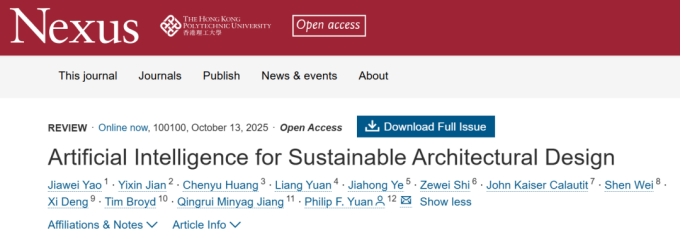
Recently, the team led by Professor Philip F. Yuan and Associate Professor Yao Jiawei from the College of Architecture and Urban Planning (CAUP), Tongji University, in collaboration with top-tier international research teams, published a research outcome titled Artificial Intelligence for Sustainable Architectural Design (AI4SAD) in Nexus, a cross-disciplinary journal under Cell Press.

The research team conducted a comprehensive search of 9,743 literature pieces published between 2000 and 2025. Through rigorous steps including double-blind screening, consistency checks, full-text reviews, and quality assessments, 408 papers were ultimately selected for the systematic review.
This study is the first to map the global spatiotemporal landscape of AI4SAD research, uncovering issues such as uneven distribution, paradigm shifts, and insufficient transparency. It also proposes a three-stage development framework for AI4SAD. The research provides a roadmap for enhancing the universality, autonomy, and interpretability of intelligent architectural design, holding significant importance for promoting the responsible application of AI in the field of sustainable architecture.
The College of Architecture and Urban Planning, Tongji University, served as the first completing institution for the paper. Professor Philip F. Yuan is the corresponding author, while Associate Professor Yao Jiawei is the first author. The core team members include Professor Tim Broyd, Director of the Centre for Digital Innovation in the Built Environment at University College London (UCL) and a dual fellow of the Royal Academy of Engineering and the Academia Europaea; Associate Professor Wei Shen from UCL; Associate Professor John Kaiser Calautit from the University of Nottingham; and Researcher Deng Xi from the University of Hong Kong, among others. The team integrates multidisciplinary and cross-regional research forces, demonstrating outstanding academic collaboration and international cooperation in the fields of artificial intelligence and architecture.
The paper can be accessed via the following link:
https://www.cell.com/nexus/fulltext/S2950-1601(25)00047-6. The full text is freely available for download.
 ABOUT US
ABOUT US




